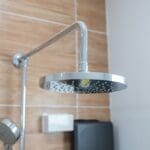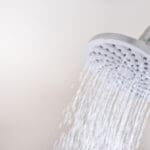Navigating the waters of DIY plumbing repairs can often feel like sailing through a storm, but fixing your leaky shower head pipe doesn’t have to be a daunting voyage. With a few tools and a bit of know-how, you’re more than capable of plugging the leak and steering your bathroom back to tranquility.
Key Takeaways
- Locate and turn off the water supply valve before working on the showerhead.
- Inspect the showerhead for damage or wear, and clean it thoroughly.
- Apply Teflon tape clockwise on the threads of the shower arm before reattaching the showerhead.
- Test the showerhead for leaks after reattaching, and troubleshoot further if necessary.
Turn Off Water Supply
Before tackling the leaky shower head pipe, you’ll need to locate and shut off the water supply valve to prevent any water flow during the repair. This valve is often found near the water meter or inside a utility room. To halt the water supply to the shower, turn the valve clockwise until it’s fully closed. After you’ve done this, it’s crucial to verify that the water flow has indeed stopped. You can do this by turning on the shower faucet; no water should come out if you’ve successfully turned off the water supply.
With the water supply cut off, you’re ready to move on to the next steps to fix a leaking shower head. Remember, when you eventually reattach the showerhead back onto the shower arm, using Teflon tape on the threads of the shower arm can prevent future leaks. This initial step of turning off the water supply is essential in ensuring a dry and safe environment to work in as you remove the shower head and address the leak.
Remove Showerhead
To remove the showerhead, first, grab a wrench and gently turn it counterclockwise to loosen. You’ll also want to wrap the pipe in a towel so your wrench doesn’t scratch the finish. This initial step is crucial in fixing a leaking shower. By removing the showerhead, you’re preparing to either repair or replace it, depending on the severity of the leak. Remember, dealing with a leak promptly can save a significant amount of water and reduce your utility bills.
Once you’ve loosened the showerhead with the wrench, continue unscrewing it by hand until it comes off. This exposes the threads on the shower arm, which are key to ensuring a tight and leak-free connection when installing a new one or reattaching the old showerhead after maintenance.
Before you proceed to wrap Teflon tape around the threads, inspect them for any damage. If the threads appear worn out, replacing the entire shower arm might be necessary to guarantee a fix. However, if they’re in good condition, simply cleaning them to remove any debris or old Teflon tape will suffice.
With the showerhead removed, you’re now ready to apply fresh Teflon tape and reattach the showerhead or replace it with a new one, ensuring a secure and leak-free installation. This straightforward process is a key step in maintaining an efficient and functional shower.
Inspect and Clean
After removing the showerhead, closely examine it for any signs of damage or wear. Inspecting the inside of the showerhead is crucial in identifying the root cause of a leaking showerhead. If you notice mineral deposits or sediment, it’s time for a thorough cleaning. Using an old toothbrush, gently scrub the interior to remove any blockages, paying close attention to the rubber O-rings and screen. This step ensures that nothing obstructs the water flow, which can contribute to leakage.
Next, focus on the threads where the showerhead connects to the water supply. Here, use the toothbrush to clean off any grime, which will help prevent scratching when you reattach the showerhead. Before screwing the showerhead back on, wrap the threads with plumber’s tape. This simple measure can significantly improve the seal and prevent future leaks.
If, after cleaning and reassembling, your showerhead continues to leak, it might indicate an issue with the faucet itself or with the hot and cold water flow. In such cases, you might need to remove the faucet for further inspection or seek professional assistance. However, regular cleaning and maintenance can often keep your shower running smoothly and leak-free.
Apply Teflon Tape
Having inspected and cleaned your showerhead, it’s crucial to apply Teflon tape to the threads for a watertight seal. This step is essential in preventing future leaks and ensuring your shower operates efficiently.
Start by measuring about 8 inches of Teflon tape. This length is sufficient to cover the threaded end of the shower pipe thoroughly.
Place one end of the tape at the base of the threads on the shower arm. It’s important to wrap the tape clockwise around the threads. This direction ensures that when you thread the showerhead back onto the arm, the tape tightens rather than unravels. Make sure the tape completely covers the threads, going around several times to create a secure, leak-proof layer.
Reattach and Test
Once you’ve wrapped the shower arm with Teflon tape, it’s time to reattach the showerhead by hand, ensuring a tight fit. Screw the showerhead back onto the shower arm carefully to avoid cross-threading, which could cause your showerhead to leak again. Initially, tighten the showerhead by hand to ensure you don’t damage the threads. If necessary, use a wrench for the final tightening, but wrap the showerhead in a cloth first to prevent scratches.
Now, it’s crucial to test your repair. Turn on the shower faucet and observe. If the shower leaking issue persists, it may indicate that the problem lies elsewhere, such as with the shower faucet or an internal component that requires attention. Should there still be water escaping, you might need to access the shower’s access panel for a deeper inspection or consider replacing a shower component entirely.
Frequently Asked Questions
How Do You Fix a Leaking Shower Head Pipe?
To fix a leaking shower head pipe, you’ll turn off the water, inspect for worn parts, and protect the shower floor. Clean the head, replace any damaged parts, and reassemble without overtightening.
How Do You Fix a Leaky Shower Drain Pipe?
To fix a leaky shower drain pipe, first identify the leak’s source. You’ll likely need to replace the faulty seal or gasket. Don’t forget to turn off the water before starting your repair.
How Do You Seal a Shower Head Pipe?
To seal a shower head pipe, you’ll need to wrap Teflon tape clockwise around its threads after removing the showerhead. Ensure full coverage before reattaching and hand-tightening the showerhead, then test for leaks.
How Do I Stop My Shower From Leaking From My Head?
To stop your shower from leaking, you’ll need to first turn off the water supply, then remove and inspect the showerhead for damage or wear. Clean it, apply plumber’s tape, reattach, and check for leaks.





